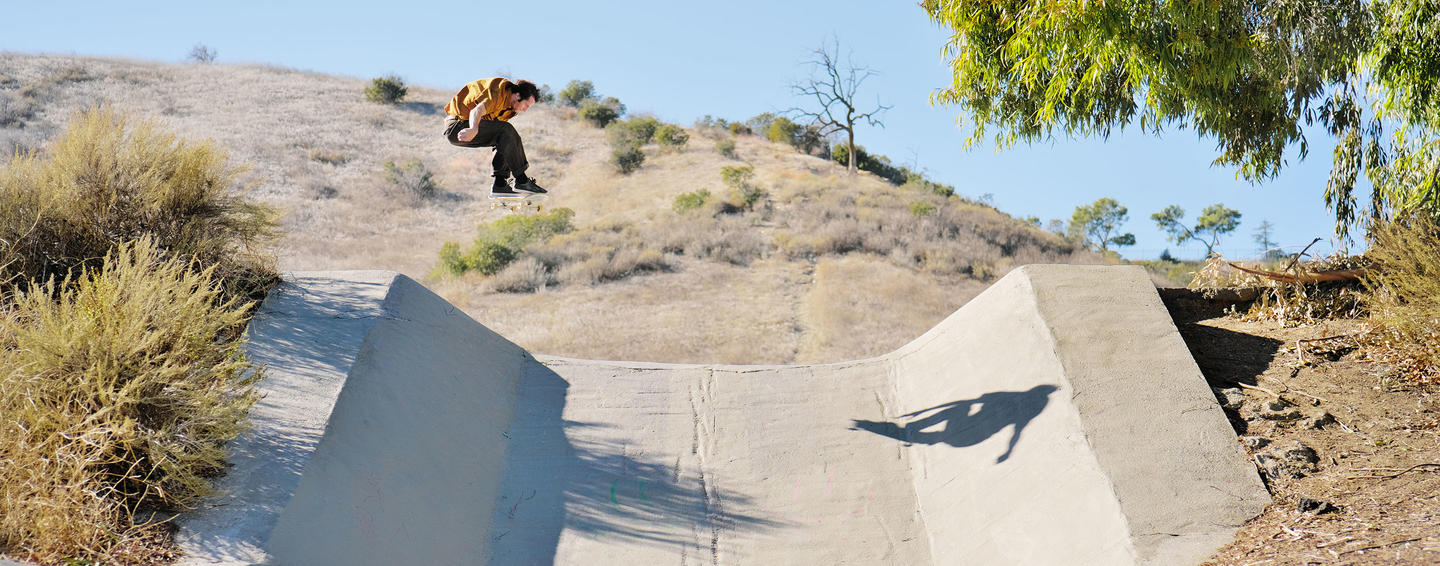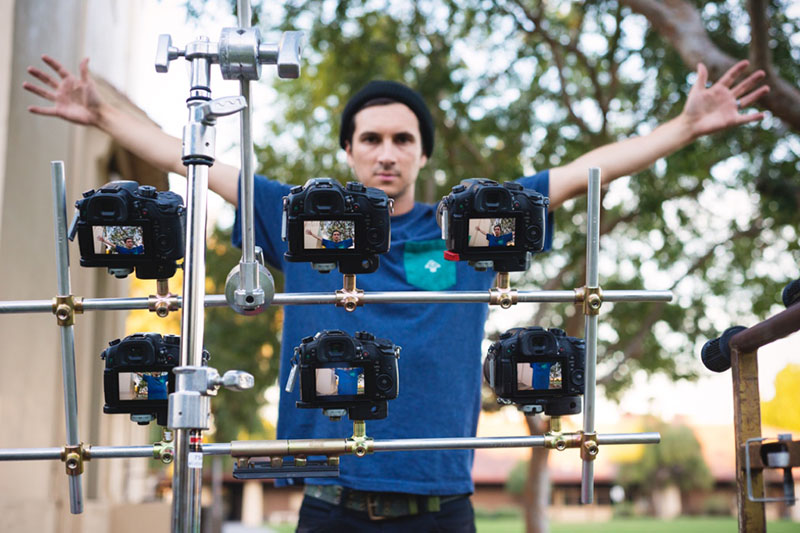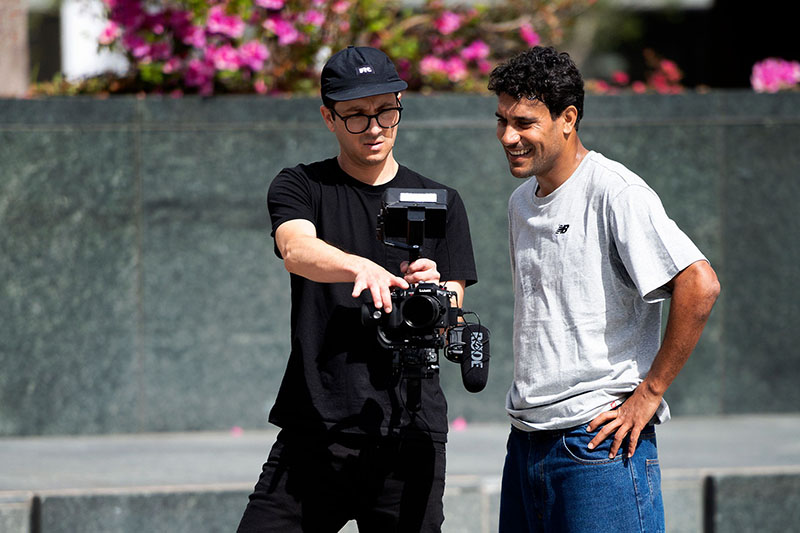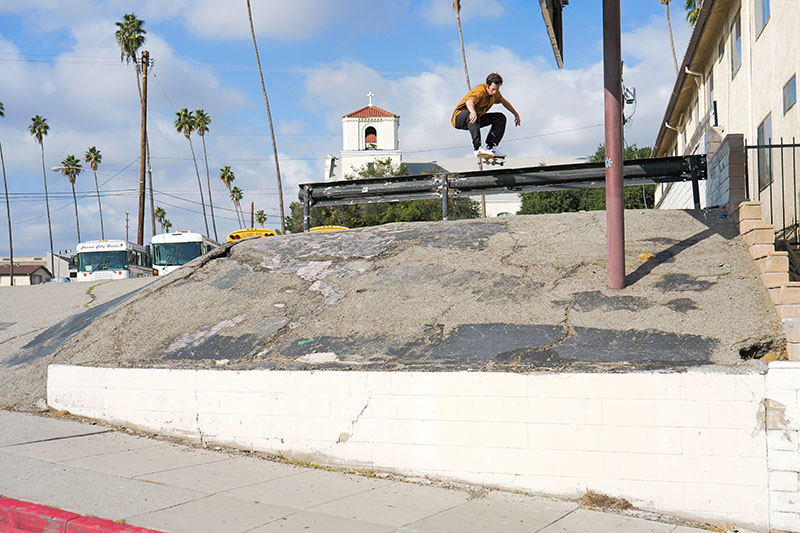Kyle Camarillo S5II

Getting the shot
Content creator and LUMIX Ambassador Kyle Camarillo skates with the S5II
Since their inception, video and skateboarding have always gone hand-in-hand. Skate videos have a long history starting in the 1960s with skateboarders showcasing early, more grounded tricks. The genre really took off in the ‘80s when skateboard legend and filmmaker Stacey Powell created The Bones Brigade Video Show, which sold over 30,000 copies on VHS. As the digital video revolution progressed – from VHS tapes to DVDs to social media (e.g., TikTok, Instagram) – skate videos have evolved with an emphasis on shorter clips in natural urban surroundings.
LA based filmmaker and LUMIX Ambassador Kyle Camarillo came into the filmmaking world through skateboarding. Growing up in the Bay Area, there was always a camera around for Camarillo to film himself and his friends skating. “Unlike a basketball game, there’s no designated cameraman,” explained Camarillo. “My dad happened to have a Hi8 video camera and I would go film my friends. We would pass the camera around trying different tricks and having fun.”
When one of his friends became a sponsored skater, Camarillo helped him create a few videos. After initial success, he was motivated to learn more about filmmaking, as well as speaking with other skateboarders and brands. For filmmaking, directors Ty Evans and Fred “French” Mortagne were Camarillo’s biggest influences, shooting dynamic skate videos with early 3CCD cameras like the Sony VX1000 camcorder. “Spike Jonze was also a good example of how a lot of people my age started because he was just starting out with a small circle of friends,” said Camarillo. “His career took off in a very inspirational way. At first, I didn’t really know what I was doing but I was just excited to be part of something.”
Inspired by the work of artist David Hockney, Camarillo created a specialized rig with LUMIX cameras to capture a unique project with a collage-like effect.
Camarillo’s early work shooting with Panasonic cameras were HVX200 and HPX170 P2 cameras. His first exposure to LUMIX cameras was the Micro-Four-Thirds GH2 in 2010, in which he captured 1080p at 24fps with a very small and inexpensive system. To this day, Micro Four Thirds is his format of choice.
GH6 Power & Versatility
For the past few years, New Balance’s skateboard line, New Balance Numeric, has been Camarillo’s main client, hiring Camarillo to run their video marketing team. He’s the main director but also works in the field shooting and editing, doing pre-production and post. He works with a small crew primarily shooting with LUMIX GH6 cameras in a loose run-and-gun style. For lenses, he primarily sticks to three zooms – a 12-35mm F2.8 ASPH X Vario Lens, 35-100mm F2.8 ASPH X Vario Lens, and Canon 8-15mm with a Metabones adapter. Camarillo shoots 75% of his footage handheld so LUMIX’s industry leading image stabilization is essential for his moving content.
According to Camarillo, the GH6 is a compact powerhouse that has everything he needs at any given time. Like a journalist or documentarian, if something interesting is happening, he needs to be prepared to get the shot immediately. “I can’t say, ‘Man, I wish I had that lens, or I wish I had brought my gimbal.’ I want everything to be small and compact, so I can have everything with me for any situation.”
Kyle Camarillo setting up a shot with a GH6.
Camarillo frequently shoots in the GH6’s 4:3 Open Gate mode. “We currently are stretching all our content to fit all these different aspect ratios such as 9:16,” revealed Camarillo. “I don't see any other way to do that, besides shooting something twice. In our world, some of these skateboard tricks might not happen again. Sometimes it might take days to pull off a specific trick, so we have to utilize that one moment through one camera as best as possible. Because of this, Open Gate has been an absolute game changer.”
Using Phase Hybrid AF and Active IS with the S5II
Camarillo recently had the opportunity to capture content with the new LUMIX S5II to test out both its Phase Hybrid AF and Active I.S. while skating. With a newly developed 24.2-megapizel 35mm full-frame CMOS sensor and imaging engine, the S5II is the first LUMIX mirrorless camera to utilize Phase Detection Autofocus (PDAF). To expand the S5II’s PDAF capabilities, Panasonic evolved the auto-focus system into Phase Hybrid Auto-Focus by increasing the AF points to 779 (from 315) to significantly improve subject tracking.
For a typical skateboarding shoot, Camarillo will typically use manual focus on his subject and keep a consistent distance and focal range. Even though he rarely uses autofocus, Camarillo feels there are situations where he would benefit from a dependable AF system and was excited that the S5II added PDAF. In his menu, Camarillo set AF to Full Area with the Detecting Subject set to Human. “I had my friend, Chris Colbourn, skate a few different locations and I wanted him to be moving fast while coming straight towards me,” explained Camarillo. “It worked perfectly and to be honest, I was really shocked at how well it worked.”
Skateboarder Chris Colbourn getting air as Camarillo uses 30-fps burst mode with PDAF set to Human tracking.
Since he’s also a still photographer, Camarillo also wanted to test out the improved Burst Shooting to capture full resolution RAW photos. Using the Electronic Shutter mode allows you to capture 30fps of 24MP RAW or RAW+JPEG up to 200 images with minimal rolling shutter distortion. With Hybrid Phase AF, working in single shot or continuous, the AF will still lock on the subject for high resolution image capture. “In my magazine shooting days, we would shoot photo sequences at around 9fps,” explained Camarillo. “Usually, it worked out because skateboard tricks aren't that long, but for this sequence I wanted to make sure I got him doing the entire trick in the air and riding down the entire bank at 30-fps. That's a lot of images. It locked on him all the way down and it looked really cool.”
Whether he is shooting with his GH6 or the S5II, Camarillo loves the look of 24p so he almost always shoots his projects at 47.95fps and works in 23.98 timeline in post to choose which shots he wants in slow motion. “I never know until we get into the editing room,” revealed Camarillo. “Because things are not scripted and I’m not entirely sure what's going to happen, if I'm shooting at 48fps I have less constraints. In the past, you would have to carry different and more specialized cameras around with you. Having just one powerhouse camera that can do all these different things gives me more time to create.”
For more information on Kyle Camarillo, visit his personal website at http://kylecamarillo.com/.
For more information on New Balance Numeric, click through here.


